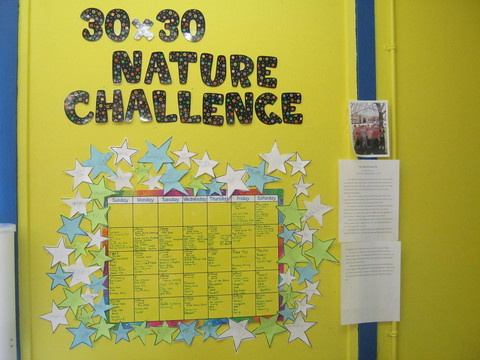David Suzuki's Blog, page 63
July 2, 2015
Better Transit and Transportation Coalition concerned about region's livability following plebiscite No result
Result doesn't mean residents reject transit and transportation improvements
VANCOUVER -- Today's disappointing No plebiscite result reinforces the need for urgent, region-wide transit and transportation improvements, the Better Transit and Transportation Coalition says.
"It was an uphill battle and we knew it wouldn't be easy. We're disappointed and concerned about the impact of this result on our region's livability," says Peter Robinson, Co-Chair and David Suzuki Foundation CEO. "However, the support from 145 groups representing more than 400,000 people from a broad range of interests for transit and transportation improvements sends a powerful message that doesn't end with a no vote." The Coalition co-chairs thanked those who voted Yes for their strong support for transit improvements.
While Metro Vancouver residents rejected the small provincial sales tax increase to fund the Mayors' Council Plan, the coalition reminds people the result doesn't mean transit and transportation improvements were rejected.
"It's impossible to say exactly why people voted no. It's unfortunate that the real issue of how we can get much-needed improvements became mixed up with issues introduced around TransLink," said Gavin McGarrigle, BTTC Co-Chair and Unifor BC Area Director. "Despite all the distractions, residents know that our traffic gridlock crisis is a huge problem in need of an immediate solution."
Concern has been raised that congestion could become debilitating as the region prepares to add one million more residents over the next 25 years.
"This result likely means years of delays before any new transit comes on-line -- with the unfortunate and predictable increase in road congestion and pollution as our population grows," says Iain Black, Co-Chair and Vancouver Board of Trade CEO. "Our economy and businesses will continue to suffer without improvements."
Governments still have to find funding for transit and transportation improvements to keep the region livable. "We must now rely on the leadership from the provincial government and the Mayors' Council to find an alternative way to fund the projects that Metro Vancouver desperately needs," says Co-Chair representing students, Bahareh Jokar, former University of BC Alma Mater Society External Vice-President. "While we wait, unfortunately, the gridlock will get worse."
The coalition recognizes the need to advocate for transit and transportation improvements for Metro Vancouver. "We are talking to our members and exploring how we can continue to advocate for solutions," co-chair Robinson says.
Hey! Want more DSF? Join David Suzuki on Facebook
Metro Vancouver's No result doesn't stop push for transit
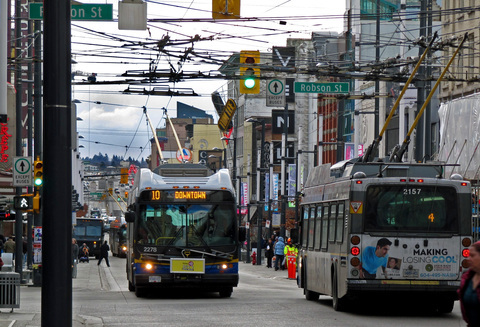
(Credit: Reva G via Flickr)
The Metro Vancouver transit plebiscite results are in. Although people in Metro Vancouver voted against a small tax increase for transit and transportation improvements, we can all take away some positive lessons from the campaign.
This result doesn't mean that people rejected transit and transportation improvements. Advocates for a No vote shifted voters' attention to issues with TransLink, Metro Vancouver's regional transit authority, and off of the transportation projects proposed by the region's mayors, making it impossible to say why people voted no.
We know there's support for better transit and transportation options in Metro Vancouver. That's why 145 groups joined the Better Transit and Transportation Coalition, the biggest and broadest coalition of its kind in B.C.'s history. That support doesn't end with a No vote.
We should remember that 38 per cent of people voted yes for better transportation and transit. That's significant. They voted for better transit to benefit the environment, economy and public health. They recognized that supporting transit and transportation improvements is the single most effective regional response to climate change. Campaigners for the No side themselves voiced support for transportation improvements, even if they didn't agree about how to achieve them.
While we at the David Suzuki Foundation accept that voters have spoken, we're concerned about the effect this result will have on the region's livability. Years of delays are likely before any new transit comes online -- with the unfortunate, predictable increase in road congestion and pollution as Metro Vancouver's population grows. It's incumbent on all levels of government to find funding for transit and transportation improvements to keep the region livable. The provincial government and the Mayors' Council must show leadership to find a way forward to fund the projects that Metro Vancouver desperately needs.
The David Suzuki Foundation would like to thank the organizations, supporters and volunteers who worked for a Yes vote, along with everyone in Metro Vancouver who voted on this important issue. It was a long campaign and we knew it wouldn't be easy to translate this complicated issue into a simple Yes or No decision.
One thing is certain and that is our commitment to transit solutions as one of the best ways to address climate change. We will continue to support research and advocate for transit improvements for Canada's large urban areas. Traffic gridlock does not have to become the new norm and emissions from transportation do not have to continue to rise.
We look forward to the innovative solutions that will lead the way to a more sustainable future.
Hey! Want more DSF? Join David Suzuki on Facebook
July 1, 2015
Chiropractic college plays outside for 30x30 workplace challenge
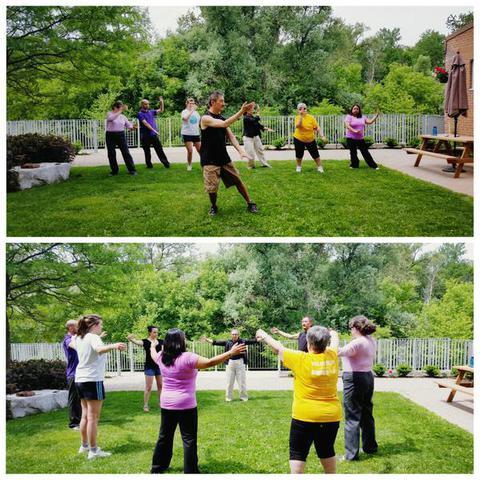
Canadian Memorial Chiropractic College staff doing some tai-chi over lunch.
This year, employees in more than 800 workplaces participated in the 30×30 Nature Challenge throughout the month of May. They spent 30 minutes outside every day, and posted photos of colleagues connecting with nature using the #natureiscalling hashtag and tagging @DavidSuzukiFDN.
Employees got creative about enjoying nature's beauty in their workplace backyards. They ran marathons, planted green roofs with native species and took long walks. Congratulations to everyone who participated! Keep finding new ways to engage your workplace outside and tag @DavidSuzukiFDN to let us know!
This year's workplace Twitter challenge winner is the Canadian Memorial Chiropractic College in North York, Ontario, led by Kavita Dogra, health and wellness committee head. Staff played Frisbee golf, enjoyed spring buds on the trails behind their building and held "Friday Footy" office soccer games. At the end of the challenge, one participant said, "It has been really great getting outdoors during the work week and I hope we get to continue doing so." Another said, "It felt good to make the outdoors part of regular work life the last few weeks." Dogra and the rest of the CMCC team all hope to find new ways to get more people excited about nature. One thing is certain: Friday Footy is here to stay!
The 30×30 workplace challenge may be over, but we're certain this year's winners will keep connecting with nature the whole year through! Will you?
Hey! Want more DSF? Join David Suzuki on Facebook
June 30, 2015
Liberals announce environmental platform
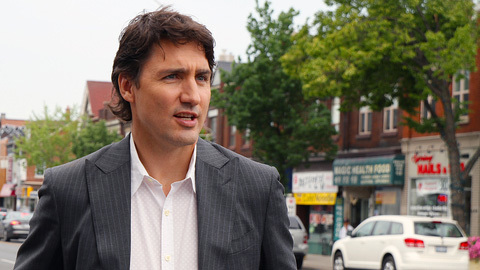
(Credit: Alex Guibord via Flickr)
The Liberal Party of Canada announced its environmental platform for the October federal election at a news conference in Vancouver on June 29. In formally announcing their environmental plans, the Liberals have set the bar for all other political parties in the coming months. The promises made the Liberals are outlined in detail at www.realchange.ca.
The David Suzuki Foundation has long advocated for clear national targets to reduce carbon emissions as well as the phase-out of fossil fuel subsidies and greater investment in renewable technologies -- including a national transit strategy. The Liberal Party platform addresses many of these concerns but has a few important gaps.
Action on climate change -- The Liberal Party proposes working with provincial governments to develop a plan to reduce emissions. Since many regions have already taken steps to cut carbon pollution, working with leaders to learn from their experiences is a good step. However, the Liberal platform does not make specific recommendations about how to guide action in provinces that are only beginning to address the problem and does not provide guidance to strengthen actions already in place.
In his speech, Trudeau said he would invite premiers from each province to attend the United Nations Climate Conference this December in Paris. While this level of cooperation is the right approach in a country as diverse as Canada, it is important that our next government not be afraid to set concrete targets and require provincial governments to meet them.
Fossil fuel subsidies -- Canada is often seen as a country with a resource-based economy whose prosperity depends on money generated by extracting oil and gas. Something that is considered less often is that to encourage oil and gas companies to invest in Canadian operations, taxpayer money is used to subsidize the industry. Not only does this practice ensure that our country generates more carbon pollution, it also makes it harder for clean, renewable technology companies to compete.
The Liberal platform promises to phase out subsidies to fossil fuel companies. The current Conservative government has made some small progress in reducing these subsidies following promises made at G7 (formerly G8) conferences, but complete elimination has proven elusive. Should the Liberal Party be in a position to follow through on this promise, the impact would be significant.
Canada's clean technology industry -- Recent research from Analytica Advisors suggests that, although Canada's clean tech industry has grown into a $12 billion per year driver of the national economy, our country has lost 41 per cent of its global market share since 2008. In recognition of this, the Liberal Party promises to invest $200 million annually into clean tech innovations for forestry, fisheries, mining, energy and agriculture. The party also pledges to invest $100 million per year in clean technology producing companies. On top of this, the Liberals hope to drive investment in the industry and create jobs through establishment of green bonds that would provide funding for the federal government to promote further clean tech growth.
In addition to focusing on climate change, the Liberal platform outlines plans to promote and preserve Canada's national parks and to strengthen protection of freshwater and marine areas -- Important promises in an era of declining fish stocks and rising ocean pollution.
Notably absent from the platform, aside from clear-cut emissions reductions targets, is recognition that a national transportation plan is critical to reducing emissions in Canada. At the municipal level, transportation contributes as much to carbon pollution as any other single factor. Investment in public transportation infrastructure drives down emissions and improves air quality and quality of life. It should be a focus for any environmental action.
Despite shortcomings in the formal plan, Trudeau made one statement that suggests a good understanding of 21st century economics: "The environment and economy go together like paddles and canoes. If you don't take care of both, you'll never get where you're going."
That may be true, but it's a long portage to election day.
Hey! Want more DSF? Join David Suzuki on Facebook
June 29, 2015
Ode to a tree named Jessica
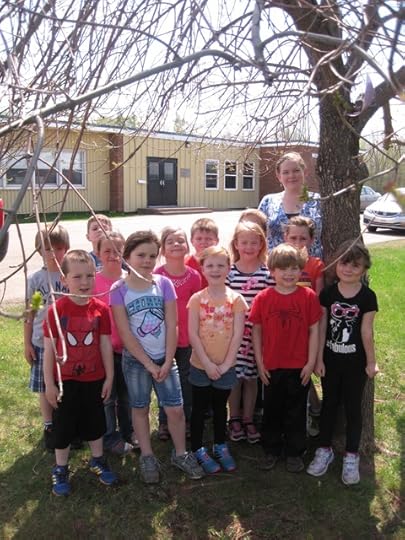
Primary students at Nova Scotia’s Wentworth Consolidated Elementary School with their tree, Jessica.
This year's 30×30 Nature Challenge reached more than 700 Canadian classrooms from coast to coast to coast. In addition to their 30 days of outdoor activities, classes were asked to adopt a tree in their schoolyards and submit photos and stories to the Foundation. We received dozens of touching tree stories -- it seemed impossible to pick just one!
Congratulations to the students of Wentworth Consolidated Elementary School in Nova Scotia!
Students in Grades 1 and 2 worked together to tell the story of their favourite tree, Jessica, chosen for her location outside the classroom window at the front of the school.
Given the school's history, students determined that Jessica had been around for a long time and had seen many changes. Their story told of the many friendships Jessica made with other trees and the schoolchildren; one student eventually grew up and stopped visiting Jessica, but many seasons later brought her son to visit and play.
The Story of Jessica Tree
Do you think you could stand still for sixty years? I have. But it was easy because I am a Maple Tree. People call me Jessica. I started as a little seed that fell from a big maple tree. That seed grew into a sapling. I dug my roots deep into the ground looking for water to drink. The warm sunshine helped me grow new leaves. I was quickly becoming a strong Maple tree.
I have seen a lot of changes in the years I have been growing. I lived in a dark, warm forest with my other tree friends. Birds and rabbits lived near my home. One day, a big machine came and cut down some of my friends. I was very sad!
Some people came and built a big building and lots of little people came to spend their days sitting inside. They sat still reading and writing all day. Every day, the children got to come outside and run around. They laughed and played, which made me wish I could join in. Wouldn't it be nice to make friends with one of them?
One special day, when the children came outside, a little girl came to me and said, "Hello." I couldn't talk, but I wiggled my leaves to her. She wiggled her hands back to me. I was so happy to find a new friend!
Every day after that, the little girl came to visit me. Sometimes she climbed in my branches. Sometimes she sat in the shade of my leaves and read me a story. Sometimes she hugged my trunk. She didn't even mind that my bark was rough and bumpy.
Over the years, the little girl grew taller and older. Eventually, the little girl stopped coming to visit me. I was disappointed that I didn't get to see her anymore. The winter wind seemed colder without her hugs. There were still lots of children playing outside, but no one came to visit me.
Many seasons passed. A woman came to say hello to me one fall day. She had a little boy holding her hand. I realized that my friend had grown up into a woman and had a son of her own. Her little boy became my new friend and visited me every day. Now I know that even though the little children keep growing, new friends keep coming to play.
-- By Grades Primary - Two, at Wentworth Consolidated Elementary, Nova Scotia
The students included this poem with their story, using their five senses to describe Jessica.
Our Poem--To Jessica
You are tall and strong,
Your bark is bumpy and rough,
Your sap is sticky and sweet,
You help the air stay clean,
Your branches are skinny and bendy,
Your trunk is nice and sturdy,
Your roots like water best,
Your buds will grow into leaves,
You shelter us from weather,
You are our favourite tree!
At the beginning of May, Wentworth Consolidated students brainstormed a list of over 70 outdoor activities they could do throughout the month. They wrote these on stars and stuck them to the wall all over the classroom. Students also shared their fun outside -- as a class and with their families -- on a wall calendar. By the end of the month, the calendar was completely full! Way to go!
Hey! Want more DSF? Join David Suzuki on Facebook

June 26, 2015
Strengthening Alberta's carbon regulations is a good interim strategy on the road to a long-term climate action plan
The Alberta government's decision to strengthen its carbon regulation for large industrial emitters, known as the Specified Gas Emitters Regulation, is a promising step toward achieving a credible climate action plan for the province. The plan to raise Alberta's existing carbon levy on a portion of industrial emissions from $15 per tonne to $20 per tonne in 2016 and $30 in 2017 shows the province is prepared to improve the local environment and protect the global climate. This announcement marks a start to what must be a more comprehensive climate action strategy for the province that should include enacting an economy-wide price on carbon pollution, phasing out coal-fired power, prioritizing renewable energy, building energy-efficient homes and businesses and investing in public transit.
The David Suzuki Foundation is encouraged to hear that provincial decision-makers will review and consider policies in place elsewhere in Canada for curbing carbon emissions, including British Columbia's broad-based carbon tax and Quebec and Ontario's cap-and-trade agreement.
"Putting a price on carbon pollution is one of the most powerful government incentives to prioritize clean energy and encourage companies and communities to pollute less," said Ian Bruce, science and policy manager for the David Suzuki Foundation. "We've seen evidence from within Canada and around the world that these incentives work when applied broadly to regional economies. We hope the government of Alberta will take that path."
Leading global organizations -- including the World Bank, World Economic Forum, Intergovernmental Panel on Climate Change and Organization for Economic Cooperation and Development -- agree that a price on carbon pollution though a carbon tax or regulatory cap-and-trade system is a critical part of an effective plan to address climate change.
"It's encouraging to see that Canada's highest-emitting province is willing to strengthen its actions to curb carbon pollution," said Jay Ritchlin, David Suzuki Foundation director general for Western Canada. "With climate change already affecting communities around the world, long-term strategies for regions with high emissions are needed immediately. I'm interested to see the next steps for Alberta."
Whether Alberta adopts a broadly applied carbon tax or a cap-and-trade system, its contribution to national efforts will be critical if Canada is to have an effective climate change action plan.
Hey! Want more DSF? Join David Suzuki on Facebook

June 25, 2015
How to make a bee bath
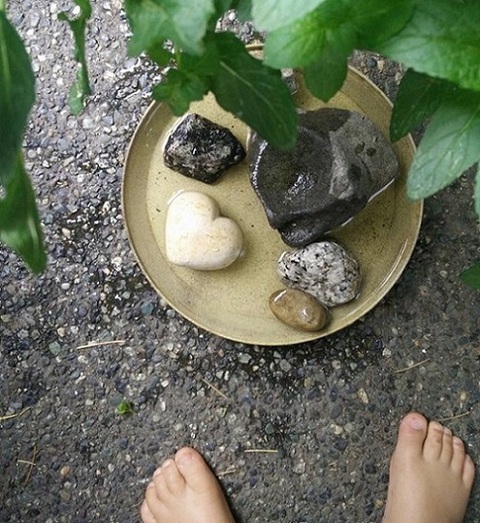
Prevent bee drownings and help ladybugs, too! (Credit: Lindsay Coulter)
We all know that bees are busy. So it makes sense that they get thirsty!
But have you ever witnessed a bee watering hole? Now you can make one.
Fact is, bees are crash landers (like those other beneficial insects, ladybugs). Open water, like a creek or pond (even a bird bath) means bees risk drowning or being caught by predators -- you've seen fish jumping out of water to catch yummy insects, right?
Prevent bee drownings -- make a bee bath! These three simple steps use ingredients already in your home. Your creation will also combat pests like aphids, because ladybugs that stop by for a sip will eat 'em!
Step 1: Place a shallow plate in your yard or garden at ground level where you've noticed bee activity. Better still, place the bee bath near sick plants to attract aphid eaters like ladybugs!
Note: Reuse a plate (maybe one that's chipped), source one from a thrift store or use a plant pot tray.
Step 2: Add a few rocks to the plate to create landing pads or islands.
Step 3: Add fresh water but don't submerge the stones. You won't encourage mosquito larvae if you keep the water level low.
It's okay if the water evaporates, refill your bee bath as needed. And don't be afraid to move it around your garden/yard.
How did you make the most effective bee bath?
Sincerely, Lindsay Coulter
A fellow Queen of Green
Hey! Want more DSF? Join David Suzuki on Facebook

Pope Francis offers hopeful perspective on global crises

(Image credit: Kris Krug via Flickr)
Earth has existed for 4.5 billion years, humans for somewhere around 150,000. But in my brief lifetime -- less than 80 years -- human populations have exploded exponentially, from two billion to more than seven billion. In that short time, we've created consumer societies and decimated the planet's natural systems, used up resources, filled oceans with plastic and pollution, altered water cycles, and upset the Earth's carbon cycle, disrupting global climate systems.
Our impacts on this small blue planet have been so rapid, widespread and profound that many scientists call this the Anthropocene Epoch. Much of it has coincided with the discovery and exploitation of fossil fuels, which showed great promise when I was a child. They were abundant and we didn't understand the consequences of recklessly burning them. Cars were designed to use lots of gas and propel oil industry profits, not to conserve energy. Factories were built to create products and increase distribution efficiencies.
No longer confined to growing food and providing agricultural services, people moved to cities and, freed from the constraints of limited access to resources, grew rapidly in number, dramatically increasing consumption.
Because our technological prowess has grown faster than our knowledge, wisdom and foresight, much of what we've created is now crashing down around us -- battered by pollution, ecosystem collapse, species extinction, resource scarcity, inequality, climate change and overpopulation.
Pope Francis recently put humanity's situation in context -- and offered hope for the future. Regardless of how you feel about religion or the Catholic Church, or even some ideas in the Pope's encyclical, there's no denying it contains a powerful, scientifically and morally valid call for radical change that will reach an audience far beyond the world's 1.2 billion Roman Catholics.
In his June 18 address, the Pope called on the world -- not just Catholics -- to recognize the need for change in the face of ecological crises such as human-caused global warming and the failure of growth-fuelled market economics to facilitate human survival, happiness and prosperity. "Never have we so hurt and mistreated our common home as we have in the last two hundred years," he said.
In his wide-ranging address, Pope Francis spoke about pollution, climate change, water, biodiversity, inequality, poverty, economics, consumerism and spirituality. "The pace of consumption, waste and environmental change has so stretched the planet's capacity that our contemporary lifestyle, unsustainable as it is, can only precipitate catastrophes, such as those which even now periodically occur in different areas of the world," he said. "The effects of the present imbalance can only be reduced by our decisive action, here and now."
He also called out those stalling or preventing action to confront environmental problems, especially global warming: "Obstructionist attitudes, even on the part of believers, can range from denial of the problem to indifference, nonchalant resignation or blind confidence in technical solutions."
Connecting the dots between environmental degradation and inequality, he urged people to "integrate questions of justice in debates on the environment, so as to hear both the cry of the earth and the cry of the poor."
Although parts of the address are bleak, the Pope argued that open conversation and changes in thinking, acting and governing could bring about positive change, even for the economy: "Productive diversification offers the fullest possibilities to human ingenuity to create and innovate, while at the same time protecting the environment and creating more sources of employment."
And, he noted, "Human beings, while capable of the worst, are also capable of rising above themselves, choosing again what is good, and making a new start, despite their mental and social conditioning."
The Pope joins a diverse global chorus of people calling for changes in our destructive lifestyle to confront crises such as climate change and the ever-growing gap between poor and rich.
These expanding and increasingly urgent calls to confront our hubris for the sake of humanity's future represent a necessary shift in a way of thinking that has propelled us along what is, after all, just a recent and brief destructive course in our history. As Pope Francis said, "We must regain the conviction that we need one another, that we have a shared responsibility for others and the world, and that being good and decent are worth it."
Hey! Want more DSF? Join David Suzuki on Facebook

June 24, 2015
Young Artists in Action get creative for the environment
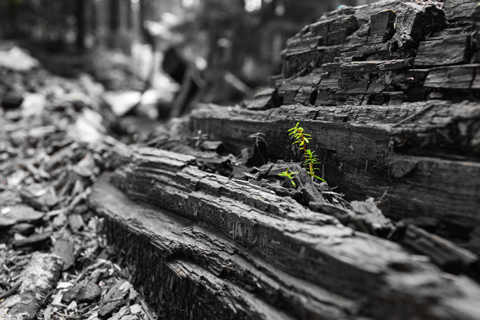
(Credit: Peter Zhang)
They called it Burgeon -- an exhibition of 150 pieces of art and a fundraiser for the David Suzuki Foundation by new Canadian youth at the Emily Carr University of Art + Design's Concourse Gallery on Granville Island in late May. The event raised $2,190.
Recently, Leon Luo, Sumi Li and Heidi Wang, the young artists who organized and worked for months to make Burgeon happen, met the recipients of their fundraising effort, David Suzuki Foundation staffers. The talented young artists and their supportive moms shared their love and support with staff and volunteers over lemon and carrot cakes, and were joined by MOSAIC senior manager Khim Tan and settlement worker Daisy Au, who connected the young artists with the David Suzuki Foundation.
It's not the first time the immigrant students from China have fundraised for a local charity. About two years ago, when Young Artists in Action received a grant from the Vancouver Foundation, the group's co-founders, Leon Luo and Sumi Li, accomplished artists and Grade 11 students at Lord Byng Secondary at the time, decided to channel their artistic endeavours to help outstanding local organizations with their work. (Last year's recipients included Kits Neighbourhood House and B.C. Children's Hospital.) But they didn't stop there; they invited peers from Vancouver high schools to join in.
According to Leon Luo, supporting the David Suzuki Foundation and hosting an environmental art exhibition exceeded his expectations. "Honestly, I never paid that much focus on how human activities have impacted our living environment," he said. "Through the process of hosting this art exhibition, I have to do a lot of background researches of the habitats we live in and how our actions have put pressure on the natural environment. Until that moment, I had no idea how serious the problem has become."
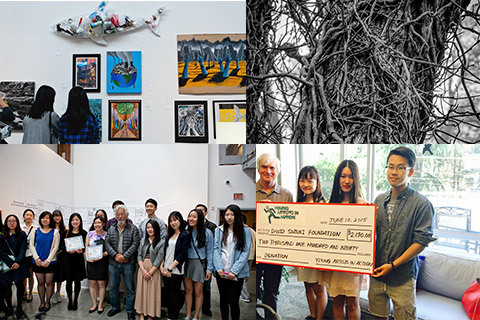
Luo is graduating from high school this summer and is headed to UC Davis in San Francisco to study cinema and digital filming. Fellow Lord Byng student Sumi Li, who is headed to Cornell University to study architecture in the fall, said the experience made her feel welcome as a new Canadian.
"DSF makes us feel that we are needed by the community and we can make a remarkable effort to protect the environment. While doing fundraising events supporting David Suzuki Foundation, we felt that we were supported by it at the same time," Li said.
Although it is sad to see them leave, it is clear the young artists' newfound awareness of environmental conservation will burgeon. As we look forward to reconnecting with Luo and Li, the David Suzuki Foundation is ready to work with the next round of environmentally conscious new Canadian students from Young Artists in Action.
You can view more pictures from the event on Flickr.
Hey! Want more DSF? Join David Suzuki on Facebook

June 22, 2015
How to reuse silica gel packs

Don't throw out silica gel packs found in vitamin bottles, packaging for electronics and leather goods -- even seaweed snacks! Instead, reuse them to combat excess moisture in your home.
Watch this video to understand how silica dries things out.
Six ways to reuse silica gel packs
Spice it up
Do you get a workout shaking clumped chili or garlic powder? Toss silica gel packs into spice jars and sugar and salt containers.
Dress it up
Add a few packs to dresser drawers and storage bins of seasonal clothing.
Camp it up
To prevent mould and mildew, add a few silica gel packs to your tent bag or the bin where you store camping gear.
De-stink it up
Got damp running shoes or stinky hockey gloves? Throw a gel pack in each one.
Sparkle it up
Prevent tarnish by tossing a few gel packs into your silverware drawer or jewelry box.
Snack it up
Reusing resealable plastic bags to store snacks and baking? Add packages of silica gel.
Note: Never ingest silica gel packs or the contents. If you find one that's damaged, dispose of it.
Where else do you think these moisture wickers could make themselves useful?
Sincerely,
Lindsay Coulter, a fellow Queen of Green
Hey! Want more DSF? Join David Suzuki on Facebook

David Suzuki's Blog
- David Suzuki's profile
- 247 followers


